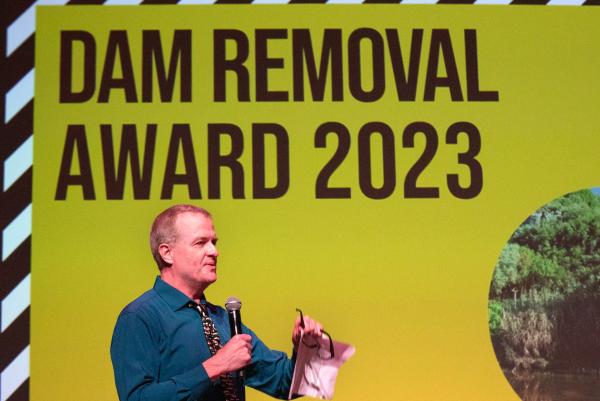World Fish migration foundation reports record numbers of dams removed from European Rivers
Image: World Fish Migration Foundation
25 Apr 2024 by The Water Diplomat

On the 15th of April a coalition of organisations operating under the name ‘Dam Removal Europe’ reported an all-time record in the removal of barriers from European rivers. In 2023, across 15 European countries, at least 487 barriers were removed, compared to 325 in 2022. Just four countries accounted for a very large proportion (83%) of these removals: France accounted for the removal of 156 barriers, Spain removed 95, Sweden removed 81 and Denmark removed 72. Nevertheless, the World Fish Migration Foundation, which published the report on the dam removals, notes a recent trend in barrier removal as a tool for river restoration in Europe: the numbers have more than quadrupled since 2020.
Against the background of global losses in biodiversity, the objective of Dam Removal Europe is to restore the connectivity of thousands of kilometers of rivers across the continent, thereby enhancing freshwater biodiversity and enabling migratory fish to access their historical spawning sites. In the 2022 Living Planet Index - a measure of the state of the world's biological diversity based on population trends of vertebrate species – populations of migratory freshwater fish have been shown to have declined by 76% on average between 1970 and 2016, and by 93% in Europe specifically.
In February, there were efforts at the European Parliament to pass the Nature Restoration Law which sets a target for the EU to restore at least 20% of its land and sea areas by 2030. Over 80% of the EU’s habitats are currently found to be in poor condition, and the nature restoration law would require EU countries to restore at least 30% of the habitats covered by the law – such as forests, grasslands, wetlands, rivers and lakes – from ‘poor’ condition to ‘good’ condition by 2030. Within this, the restoration law sets a priority for the Natura 2000 areas - a network of protected areas covering Europe's most valuable and threatened species and habitats.
However, although the European Parliament adopted the Nature Restoration law in February, was adopted in February with 329 votes in favor, 275 against and 24 in abstention, it did not achieve the qualified majority of 55% of EU countries representing 65% of the EU population. Finland, Hungary, Italy, Poland, the Netherlands, and Sweden were opposed to the law and therefore it is currently in legal limbo.
Nevertheless, the EU’s Biodiversity Strategy for 2030 already commits the region to the restoration of rivers through the removal of barriers. It states that “greater efforts are needed to restore freshwater ecosystems and the natural functions of rivers in order to achieve the objectives of the Water Framework Directive. This can be done by removing or adjusting barriers that prevent the passage of migrating fish and improving the flow of water and sediments. To help make this a reality, at least 25,000 km of rivers will be restored into free-flowing rivers by 2030 through the removal of primarily obsolete barriers and the restoration of floodplains and wetlands”.
At the UN Water Conference in New York in 2023 – the first such conference in 46 years – one of the commitments announced was the Freshwater Challenge: this goal aims to restore 300,000 kilometres of degraded rivers worldwide as well as 350 million hectares of degraded wetlands. 46 countries have now become members of this challenge.
